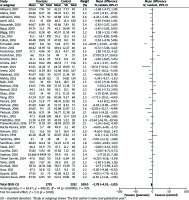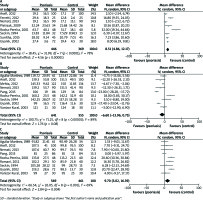Introduction
Psoriasis is one of the most common T cell-mediated inflammatory skin diseases with an unknown aetiology and a prevalence of about 1–3% in the general population [1–3]. Psoriasis can be caused by the combined effects of genetic and environmental factors on the immune system [4].The disease is associated with abnormal plasma lipid metabolism and oxidative stress [3].Psoriasis is accompanied by metabolic disturbances and cardio-metabolic disorders, and fatty acids may be a link between psoriasis and its comorbidity [5].Inflammatory activity in psoriasis acts independently as a cardiovascular (CV) risk factor [6].In psoriatic patients, lipid abnormalities are correlated with increased mortality due to myocardial infarction and stroke [7].Psoriasis area and severity index (PASI) score is used to grade the cases into mild, moderate, and severe. This score is considered outstanding when severe cases are involved. It also provides an advantage for a large base of studies in which it has been used for comparison [8]. The severity of psoriasis is correlated with body mass index (BMI), especially with abdominal fat, which represents the source of production of a complex network of adipokines [2].Plasma lipoproteins, besides their important role in the bulk transport of lipids, are also involved in maintaining a proper lipid composition of cell membranes [9].The plasma concentration of the major apoprotein of low-density lipoprotein (LDL), apolipoprotein B (Apo B), is frequently increased in patients with coronary disease, while apolipoprotein A1 (Apo A1), the major protein component of high-density lipoprotein (HDL) is an antiatherogenic factor [10].Apo B transports all potentially atherogenic very low-density lipoprotein (VLDL), intermediate-density lipoprotein, and LDL particles [11].
Aim
The aim of the present meta-analysis was the evaluation of lipid, lipoprotein, and apolipoprotein levels in the psoriatic patients compared with the control subjects.
Material and methods
This meta-analysis was designed based on the guidelines for the preferred reporting items of the systematic review and meta-analysis (PRISMA statement) [12].
Search strategies
Four databases, including Web of Science, Scopus, PubMed, and Cochrane Library were searched for evaluation of serum lipid, lipoprotein, and apolipoprotein levels in psoriatic patients using the search terms “lipid or lipoprotein or apolipoprotein”, “psoriasis”, and “serum”. The search was done for publications until July 2017.
Study selection
The studies were searched for assessment of serum lipid, lipoprotein and apolipoprotein profiles of psoriatic patients compared with the healthy controls in English abstracts. Studies were included if they were case-control ones with two groups (psoriatic patients and healthy controls), they evaluated the serum profile, including the mean/median lipid or lipoprotein levels, the healthy controls did not have any systemic or other relevant skin diseases, and the patients had just psoriasis; studies including patients with psoriatic arthritis were excluded. Reviews, letters to editor or case reports, and studies not having full-text, not reporting mean or median of serum levels, or having no relevant data were excluded from the analysis. The exclusion criteria in most studies for the psoriatic patients and controls included concomitant diseases potentially disturbing lipid metabolism (i.e. CV, hypertension, diabetes mellitus (DM), thyroid gland disorders, nephrotic syndrome, chronic kidney failure, and obstructive liver disease), any systemic medication known to affect lipid metabolism or evaluate immunological parameters for a specified period and studies including patients with a recent history of infections.
Data extraction from studies
Three authors did the process of data extraction. The first author (M.S.) searched the studies and screened titles and abstracts of every study based on the above-mentioned criteria and extracted data. The second author (M.R.) independently re-checked the full texts of screened studies. Data collected for every study included the first author, year of publication, journal, country, sample size of patients and controls, percentage of male patients and controls, mean age of patients and controls, BMI of patients and controls, mean PASI of patients, serum total cholesterol, triglyceride (TG), LDL, HDL, VLDL, lipoprotein a (Lp(a)), Apo A1, and Apo B levels of patients and controls. Lipid and lipoprotein levels were measured by the standard enzymatic method in most studies and mean values were expressed in mg/dl. The third author (E.Z.) resolved the disagreement between the two previous authors.
Quality evaluation
The quality of the questionnaires was evaluated using the Newcastle-Ottawa Scale (NOS) with a total score of nine for every study, 7–9 as high quality, 4–6 as medium quality, and 0–3 as low quality [13]. The quality of every study was evaluated by two authors (M.R. & M.S.) by reaching a consensus via discussion. Therefore, a study with a score ≥ 7 was found to have a high quality.
Statistical analysis
A random-effects meta-analysis was done by Review Manager 5.3 (Rev Man 5.3, The Cochrane Collaboration, Oxford, United Kingdom) using mean difference (MD) and 95% confidence intervals (CIs). The Q and I2 statistics were used to assess heterogeneity between the estimates. For the Q statistic, heterogeneity was considered if p< 0.1, and p-value (2-sided) < 0.05 was considered statistically significant in other analyses. In addition, publication bias was assessed through funnel plot analysis along with Begg’s and Egger’s tests. We used a formula for estimation of mean and SD if the study reported median plus range and for estimation of SD if the study reported standard error (SE) [14, 15].The units of serum lipid and lipoprotein levels were mg/dl. In a number of studies, the VLDL level was estimated by the formula VLDL = triglyceride/5.
Results
Literature search
Out of 580 studies identified in four databases, after removing the duplicate ones, 362 studies were screened (Figure 1). Among these, 288 studies were excluded because they were not relevant, and 74 studies were evaluated for eligibility. At last, 25 other studies were excluded for reasons reported in Figure 1, so a total number of 49 studies were included and analysed in meta-analysis.
The studies were published between 1989 and 2017. The meta-analysis included 2600 psoriatic patients and 2358 healthy controls. The mean age of patients was 40.89 years (range: 26.03–49.70 years) and that of healthy controls 39.64 years (range: 23.40–49.48 years). Thirteen studies were reported from Turkey [16–28], eight from Iran [11, 29–35],seven from India [36–42],five from Poland [5, 43–46], three from the USA [47–49],two from Spain [2, 10],Japan [50, 51],Egypt [52, 53],and Italy [54, 55],one from Austria [56],Romania [1],Portugal [57],Iraq [58],and China [59].Three studies [5, 47, 56]reported the median and one study [57]reported SE, which were converted to mean and SD, respectively. A full description of the examined studies can be found in Supplementary Table S1 and Supplementary Figure S1.
Lipid and lipoprotein profiles
The pooled analysis showed that MD of studies reporting serum total cholesterol levels in psoriatic patients compared with healthy controls was 13.74 mg/dl (95% CI: 7.72–19.75; p< 0.00001), with heterogeneity of 90% (Figure 2). The results showed that the mean total cholesterol level was significantly higher in the patients than the controls.
Figure 2
Forest plot of random-effects model of serum total cholesterol levels in psoriatic patients compared with healthy controls
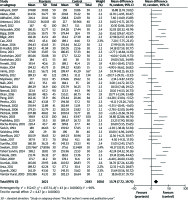
The pooled MD for comparison of serum TG levels in the psoriatic patients compared with the controls was 26.04 mg/dl (95% CI: 20.77–31.31; p< 0.00001), with heterogeneity of 74% (Figure 3). The result showed that the triglyceride level in the patients was significantly higher than in the controls.
Figure 3
Forest plot of random-effects model of serum triglyceride (TG) levels in psoriatic patients compared with healthy controls
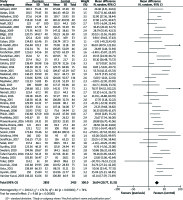
Figure 4 shows the mean levels of LDL in the patients compared with the controls. The pooled MD was 11.41 mg/dl (95% CI: 6.26–16.57; p< 0.0001) with heterogeneity of 89%. Therefore, the LDL level was significantly higher in the patients than in the controls.
Figure 4
Forest plot of random-effects model of serum low-density lipoprotein (LDL) levels in psoriatic patients compared with healthy controls
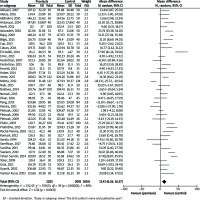
A random-effects meta-analysis of serum VLDL levels in the psoriatic patients compared with the controls is shown in Figure 5. The pooled MD was 4.82 mg/dl (95% CI: 3.63–6.00; p< 0.00001) with heterogeneity of 77%. The level of this lipoprotein was significantly higher in the patients than in the controls.
Figure 5
Forest plot of random-effects model of serum very low-density lipoprotein (VLDL) levels in psoriatic patients compared with healthy controls
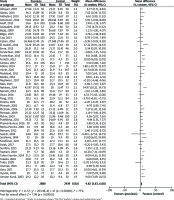
The results of serum HDL levels in the psoriatic patients compared with the controls are reported in Figure 6. The pooled MD was –2.78 mg/dl (95% CI: –4.53 – –1.03;p< 0.002). The level of this lipoprotein was significantly lower in the patients than in the controls (heterogeneity = 91%).
Apolipoprotein profiles
The studies reporting Lp(a) levels in the patients compared with controls showed that the pooled MD was 8.51 mg/dl (95% CI: 4.86–12.17; p< 0.0001), indicating that serum Lp(a) was significantly higher in the patients than in the controls (heterogeneity = 78%), (Figure 7 A). Figures 7 B and C show the results of Apo A1 and Apo B, respectively. The pooled MD of Apo A1 was –6.60 mg/dl (95% CI: –13.96 – 0.75; p< 0.08) and that of Apo B was 9.70 mg/dl (95% CI: 3.02–16.39; p< 0.004), and heterogeneities were 89% and 69%, respectively. Therefore, there was no significant difference between the patients and the controls in Apo A1, but Apo B level was significantly higher in the patients than in the controls.
Quality evaluation
Supplementary Table S2 shows the quality score for studies included in meta-analysis; indicating the mean quality score of 6.1 (medium quality). Nineteen studies had high quality (score ≥ 7).
Publication bias
Supplementary Figure S2 shows the funnel plot of studies included in each analysis. Begg’s and Egger’s tests did not reveal significant evidence of publication bias among the included studies in each subgroup.
Discussion
This extensive meta-analysis evaluated the lipid and lipoprotein levels in psoriatic patients compared with healthy controls. The results showed that total cholesterol, TG, LDL, VLDL, Lp(a) and Apo B levels were significantly higher in patients, the HDL level was significantly lower in patients than controls, and the Apo A1 level was similar in two groups. It is still controversial whether changes in lipid composition are primary events or secondary to psoriasis, or perhaps due to medications such as cyclosporin and retinoids [16, 50].It is also still debated if activation of the immune system in psoriasis may cause some changes in patients’ lipid profile, hence in this category of subjects an acceleration of atherosclerosis processes in comparison with the general population has been shown [30, 33, 54].Additionally, psoriatic patients can be at increased CV risk, even after group matching on the basis of BMI [43, 48, 57]. Apo A1 has been advocated as a strong predictor of CV events, with potential advantages over HDL [33].
Apo A1 has protective effects against CV disease, whereas Apo B increases the CV risk [11].Some evidence showed that Apo B might be a better predictor for CV disease than LDL [3].The carriers of PON1 M allele have distinctly reduced ApoA1 levels, but have increased Lp(a) and Apo B levels. These findings indicate that this polymorphism may be involved in the development of atherosclerosis and cardiovascular diseases (CVD) in patients with psoriasis. In general terms, a strict relationship between psoriasis, lipoproteins and oxidative damage does exist [33].Cholesterol and LDL levels have been found to be higher in psoriasis, which could be related to the same pathogenesis of psoriasis and atherosclerosis [60].Another factor that could contribute to the atherosclerotic process and subsequent CV events is represented by the increased carotid mean intima-media thickness (IMT); and this is of great importance in neurological diseases, since it plays a strong role in ischemic cerebrovascular events (strictly related to CV diseases) [61].Increased IMT as well as a high prevalence of metabolic syndrome have been already reported in psoriatic patients [62–64].Moreover, metabolic syndrome is closely linked to bad life habits leading to overweight/obesity and inactivity; in this regard, lifestyle factors such as smoking, alcohol consumption, sedentary lifestyle, and systemic psoriasis therapy may influence CV risk factors and may have a negative direct impact on these risk factors [26, 39, 47, 49, 64, 65].
Epidemiological studies have demonstrated that smoking is not only a risk factor for psoriasis, but it also increases the severity of psoriasis while lowering the response to treatments [66].Serum HDL levels were found to be significantly lower in the smoker patients than in non-smoker controls; whereas, the serum TG levels were significantly higher. There was no compelling difference among the non-smoker patients, both control groups, and smoker patients regarding serum lipids, and PASI levels were significantly higher in smoker patients than in non-smoker patients, as previously reported by Emre et al. [22].Therefore, HDL levels have protective properties against the CV risk [45].Smoking increased the psoriasis risk nearly two folds [42].Obesity is a known risk factor for psoriasis development and may be correlated with psoriasis activity. Psoriatic patients have a higher prevalence and incidence of obesity, and those with more severe skin lesions have higher odds of obesity than those with mild psoriasis [67].
In observational studies, it has also been reported that the risk of systolic hypertension was two times higher in psoriatic patients than in the general population, and more severe the development of psoriasis the higher the risk of hypertension [68].On the other hand, it has to be taken in account that some antihypertensive drugs can play a role in inducing psoriasis, and, among them, β-blockers and sartans (i.e. losartan) are the most famous ones [69].So, in case of patients suffering from hypertension, administration of certain category of drugs (β-blockers, sartan molecules) might be avoided. This fact could probably represent a bias in some studies. It can be concluded that psoriasis may be an independent risk factor for diseases such as ischemic heart disease, DM, hypertension, and obesity [32].Conversely, long-term hypertensive status is associated with an increased risk of psoriasis [46, 68].
Increased Lp(a) levels and modifications of biochemical markers of lipid peroxidation related to the severity of psoriasis could be involved in the pathogenesis and progression of the disease and related complications [55].Increased Lp(a) levels may also affect the expression of vascular adhesion protein 1 (VAP-1) or its activity in the adhesion and migration of T cells, thereby increasing the risk factor for psoriasis and its complications [11].Therefore, lifestyle, eating habits, smoking and alcohol are important components that increase the incidence and severity of psoriasis. Also, some systemic diseases such as high blood pressure, DM, etc. can be other risk factors for this disease. Overall, lipid and lipoprotein changes in psoriatic patients, compared with healthy subjects, can be primary or secondary factors involved in the development of the disease, which should be considered in the first visit or during the patients’ follow-up, thus even conditioning the choice of treatments.
There were several limitations in this meta-analysis. First of all, smoking and alcohol consumption had not been controlled in a lot of studies. Secondly, PASI score was different in the studies, although PASI score can easily change in the same patient during life (and not only in relation to treatment of psoriasis). Thirdly, in some studies the patients with psoriasis had metabolic syndrome, unless it is well-known that psoriasis is strictly associated to metabolic syndrome, thus leading to an increased risk of CV events (as stated above) [64].Fourthly, there was a high heterogeneity among analyses. But the strengths of this study were: 1) age, sex, and BMI had been matched in the most studies; and 2) there was no bias in the analyses.
Conclusions
This extensive meta-analysis showed abnormality of serum lipid, lipoprotein, and apolipoproteinlevels in psoriatic patients, compared with controls, and possibly a greater risk of atherosclerosis and CV accidents in the patients. Therefore,psoriatic patients should be risk-evaluated for CV accidents and atherosclerosis and should be carefully screened for lipid abnormalities, which can help in the early detection of lipid dysfunction and comorbidity of CV and atherosclerosis.










